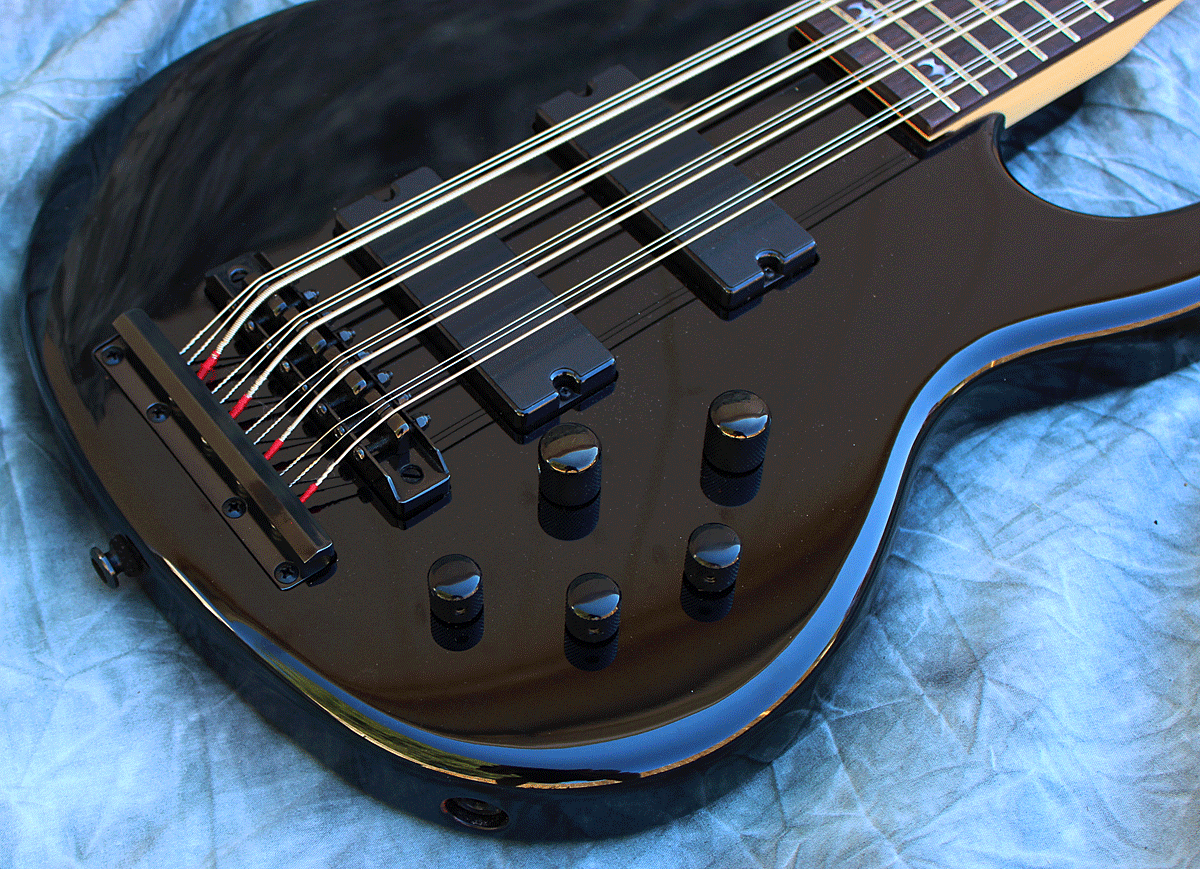12-String Bass Misinformation
There are a wide variety of stories about 12-string basses and the people who play them that are repeated on websites and message boards throughout the internet. Many are factual, but some seem to have been concocted by people who are heavily involved with recreational pharmaceuticals. We will track down these stories and set the record straight whenever possible.
The most common misconception about the 12 is that they are strung in 3 octaves. Invariably this mistake is reported by somebody who has never actually seen a 12-string bass, let alone played one. See our Tech section for the facts.
There are albums by many artists that were released prior to 1978 that include references to a "12-string bass" in the credits. Invariably these references are referring to bajo sextos or baritone guitars, not the tripled-strung bass guitars that are the subject of this website.
Billy Sheehan's 12-String Bass?
Billy Sheehan and his baritone 12-string guitar.
On some websites it was claimed that master bassist Billy Sheehan (Mr. Big, Steve Vai, David Lee Roth) plays a 12-string bass, and also that his 12-string is strung Inverted to allow him to play it fingerstyle rather than having to use a pick. We contacted Billy in 2005:
"Hi Mark. Actually it's a baritone 12-string guitar, not a 12-string bass. It's tuned B-E-A-D-F#-B with octave strings for the low B, E and A and double strings on the D, F# and high B. I play it with a stone pick like a regular guitar. It's used on my solo CD 'Compression'. I don't play any instrument 'inverted' as mentioned - don't know where that one came from!”
“Your friend, Billy"
Editor’s note: Billy Sheehan acquired a Musicvox Space Cadet 12-string bass in 2020.
Aerosmith didn’T use a 12 on "Rocks"
In 1976, Fender 6-string basses such as this one were uncommon but not really difficult to find.
It has been stated that guitarist Joe Perry of Aerosmith recorded the song "Back In The Saddle" from the "Rocks" album using a 12-string bass. "Rocks" was released in 1976 - two full years before the first 12-string bass was built by Hamer Guitars. How this bogus story got started is unknown but the truth is printed right in the liner notes. Joe Perry is listed as playing "Six String Bass" on "Back In The Saddle", and no 12-string bass is listed anywhere. End of story.
No 12-string bass has ever been used on any Aerosmith album, nor has a 12-string bass ever been used in a live Aerosmith show. Aerosmith bassist Tom Hamilton received a Chandler Royale 12 in late 2003 from Chandler Guitars to use on recordings. Due to a change in the Aerosmith touring schedule he wasn’t able to record with the 12 so he returned it to Chandler (and shortly thereafter that 12-string bass found a home with Shalini Chatterjee).
David Hull playing a Hamer Standard 6x2 12-string bass in The Joe Perry Project.
It is rumored that Joe Perry owns a Waterstone TP-1 12-string bass although no photos have thus far surfaced of Joe with that bass. Perry does own a 1979 Hamer Standard 12-string bass but that bass is a doubled 6-string rather than the 4x3 format. This is probably the source of this errant “Rocks” story because the bassist in Joe Perry’s band, David Hull, played this 6x2 Hamer Standard 12-string bass in the Joe Perry Project.
No, this isn’t real…
… but it would have been cool if it was, eh?
The Press Gets It Wrong - A Lot!
It always astounds us how often the press gets their information wrong, uses outdated photos, misquotes interviewees, or seemingly just makes up stuff. And surprisingly, this happens even when the press writers have written information or press releases in hand that gives the actual details.
This article from 1979 states that Tom Petersson creates his big sound through the use of bass synthesizer pedals, plus electronic devices are used to add extra vocal harmonies. Completely bogus.
Photo from the January 11, 1992 issue of Kerrang! magazine that misidentifies Pete Comita (who left the band in 1981) as Tom Petersson. Yes, they look similar, but where did this long-obsolete photo come from?
In fairness, sometimes the press doesn’t have access to all the information they need, and this story is interesting if true: Rockline! magazine (Summer 1981 issue) includes a story about Pete Comita that states no interviews had been published with the new Cheap Trick bassist because all interview requests had been denied.
